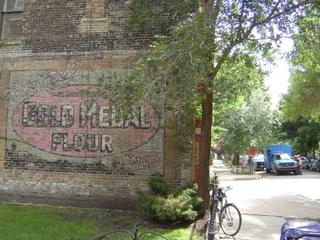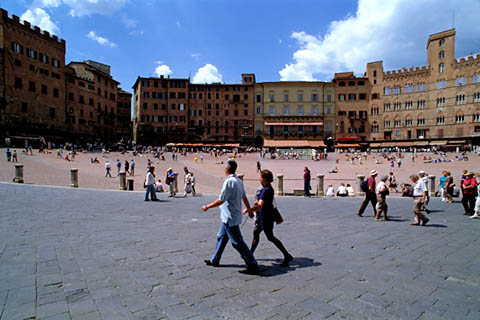It has been a sad few weeks watching the good people of the Delta suffer through unthinkable fallout from the hurricane. As my sister-in-law Laura put it, "They suffered two tragedies: Katrina and the relief effort."
Here are just a few things I want to comment on in the wake of this catastrophe.
You Can Take the People Out of the City, but You Can't Take the City Out of the People: New Orleans MetrobloggersAs someone who reflects on the meaning of place for a hobby, I can not think of a more unique place in this country than New Orleans. It was impossible for a visitor to leave that town without a suitcase of lush memories.
Tasting my first beignet. Ordering a Hurricane. (Think of it -- that was the name of the must-have-knock-you-on-your-feet-come-home-with-a-woman-shaped-glass- drink!) Strolling the French Quarter, always a little leery for my safety. Avoiding the rowdy, "show-us-your-tits" revelers whose numbers rose as night fell. Hearing Mose Allison and one of the Marsalis's at
Snug Harbor. (Their website defies the tragedy. Ellis Marsalis plays there this weekend it says. The September concert schedule is full.)
New Orleans was, is, and will be distinctly
a place because of its history, architecture, culture, and people.
The
New Orleans Metrobloggers (sister to Chicago's Metroblog to which I contribute) have been providing rich coverage of the place where they live (and have been displaced from) and the impact of the tragedy. Their posts are lessons in the meaning and importance of place in our lives.
Here are some recommended posts:
- Chris Martel rebuts Washington Post editorial entitled "A Sad Truth: Cities Aren't Forever." Hearty debate follows.
- Craig Geisecke writes about his desire to return to NO. I think this is my favorite statement that I've read anywhere about New Orleans the place:
I started to post yesterday about the overall situation with the evacuees -- thousands of us out on the road and looking for a place to land. An entire culture on the move. In one place on this forum, I saw us compared to those waiting in Casablanca for the plane to Lisbon. That's as apt as any, since there's an element in us that's not going to be happy until we get out of where we are and back where we belong. Where we are is safe -- and that's exactly what's wrong with it.
Ships are safe in the harbor, but that's not what ships are made for. New Orleans is, as much as New York and a few other cities, a combination of the terrible, the unique and the sublime. Often all in the same room and sharing the same table.
- Craig Geisecke also wrote this compelling and beautiful post about returning to a place you know so well after it's just gone through something awful:
I wangled media credentials for trip over the Crescent City Connection early this morning. We drove past the badly-looted Wal-Mart on Tchoup (carts and racks are scattered for blocks). The place is now a military staging area.
We went down Tchoup, right on Second, left on Constance and left on Third before we parked near Parasols (which lost its awnings, but that's about it). Lots of downed trees and power lines, but brick buildings appeared to have more damage than wooded ones (note to Laura -- your house appears untouched). We lost only one small upstairs window, which I covered with a plastic trash bag.
Down Third, right on Annunciation, then right on Fourth because we were blocked by a crushed truck. I was taking a picture when I hear men talking to Kim nearby. I turn around and see her with three National Guardmen, heavy weapons drawn. Turns out they were chasing a looter who had vanished between houses.
Up to St. Charles, right to Jackson, then back to Tchoup and out the way we came. Took 90 to Houma, Morgan City, then up to Lafayette and finally here.
Weird thing last night wasgoing through the I-10/I-12/I-59 interchange in Slidell. It's usually lit like Vegas on Christmas, but now it's this inky, velvet black except for the headlights. Iffy power until you get to about Covington.
Lots of emotion today. I'm still processing. More later after I catch up.
- Those of us who blog on Metroblogs don't get paid for it. We do it because, well, we love the place where we live and we think it's fun. The guy who started all this, Sean Bonner, set up a CafePress store where you can buy "I 'heart' NOLA" sportswear. ALL the proceeds will go to the New Orleans Metrobloggers and their families. Please consider buying something from them. My tank top arrived today. I can't wait to put it on tomorrow. Really, I mean that. I am bursting with good will for that region. Now I have a t-shirt to assist me.
Area Man Drives Water There His Goddamned Self
We spent a lot of the weekend packing up grocery bags of supplies for Katrina victims. My alderman had sent out a list and notified us of two trucks leaving from Reebie Storage on Clark Street.
My son cleaned up a Power Rangers scooter he had outgrown. He sprayed it with the orange cleaner we use on the kitchen counters and wiped it dry with paper towels. He rode with us to the moving company. Then, he hoisted it to the truck loading bay and watched the Reebie folks move it to a pile with the bedding and canned goods and bottled water.
"When will the trucks get there?" he asked.
I predicted this morning. Was I right? Did it make a difference? Whose little boy is riding the scooter now? Many blessings to them all.
(The header above is borrowed from The Onion's Katrina headlines.)
The Best of New Orleans' Great Space
Here is a summary of the "Great Public Places" in New Orleans via the Project for Public Spaces. I found myself wanting to know more about what might have been lost or saved in NOLA. Thought you might wonder the same.
Artillery Park A combination urban scenic overlook, river overlook and informal
amphitheatre for street performances.
USA
City Park A large city park with activities ranging from weddings to paddle boats to an art museum.
Crescent City Farmers Market A gentle farmers' market made distinctive by its location: the walls of the parking lot are covered in beautiful full-scale murals of rural farming scenes.
French Market New Orleans once had markets in nearly every neighborhood; this place, with the longest and most colorful history, is the last in operation.
French Quarter
Colonial Spanish architecture, great New Orleans food and jazz, plus the highest
concentration of colorful characters in the whole USA.
Jackson Square This lively and heavily trafficked park in the French Quarter is a popular site for artists, street performers and musicians who entertain tourists and locals.
Latrobe Park A small park with ample seating and lush planting.
Lower Garden District Neighborhood with an extensive collection of 19th-century residential and commercial buildings, many pre-dating the Civil War.
Pirates Alley A pedestrian walkway between historic buildings, The Saint Louis Cathedral and the Cabildo.
St. Charles Avenue Streetcar Line Historic avenue, greenway and transportation corridor
Vietnamese Farmers' Market At 5am each Saturday, over 20 vendors set up shop in a dilapidated shopping square, spreading out produce on blankets; live ducks, rabbits and chickens wail to a background chanting of Asian pop music.
 That's the slogan of the National Building Museum. They're a non-profit organization dedicated to supporting and exploring our built environment from the viewpoints of construction, urban planning, design, architecture, and engineering.
That's the slogan of the National Building Museum. They're a non-profit organization dedicated to supporting and exploring our built environment from the viewpoints of construction, urban planning, design, architecture, and engineering.


 It is hard to believe that the
It is hard to believe that the 
